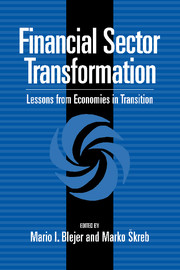Book contents
- Frontmatter
- Contents
- List of Contributors
- Introduction: Financial Reforms and Economic Transition: An Overview of the Major Issues
- PART I GENERAL STUDIES
- PART II COUNTRY STUDIES
- 5 Banking Crises in the Baltic States: Causes, Solutions, and Lessons
- 6 Monetary and Exchange Rate Policy, Capital Inflows, and the Structure of the Banking System in Croatia
- 7 Monetary and Financial Market Reform in Transition Economies: The Special Case of China
- 8 The Financial Sector and High Interest Rates: Lessons from Slovenia
- 9 Bank Rehabilitation in Slovenia: With Emphasis on Nova Ljubljanska Banka
- 10 Liberalization and Financial Reforms: Lessons from the Israeli Experience
- PART III AFTERWORD
- Index
10 - Liberalization and Financial Reforms: Lessons from the Israeli Experience
Published online by Cambridge University Press: 05 November 2011
- Frontmatter
- Contents
- List of Contributors
- Introduction: Financial Reforms and Economic Transition: An Overview of the Major Issues
- PART I GENERAL STUDIES
- PART II COUNTRY STUDIES
- 5 Banking Crises in the Baltic States: Causes, Solutions, and Lessons
- 6 Monetary and Exchange Rate Policy, Capital Inflows, and the Structure of the Banking System in Croatia
- 7 Monetary and Financial Market Reform in Transition Economies: The Special Case of China
- 8 The Financial Sector and High Interest Rates: Lessons from Slovenia
- 9 Bank Rehabilitation in Slovenia: With Emphasis on Nova Ljubljanska Banka
- 10 Liberalization and Financial Reforms: Lessons from the Israeli Experience
- PART III AFTERWORD
- Index
Summary
In this chapter, I discuss the experience of Israel regarding some of the issues covered in this volume, particularly with respect to the recent financial sector reforms and capital market liberalization. Although Israel does not, of course, belong to the group of countries covered here, its experience seems highly relevant for many economies in transition.
Modern Israeli economic history begins in 1985. Before that year, the country was experiencing an inflation rate of 450 percent that was reduced, within a year, to 18 percent. This relative stabilization was achieved by a deep budget cut by which the budget shifted from a deficit of about 15 percent GDR to a small surplus in a period of less than two years. This happened without any reduction in growth. While these and many other developments that accompanied the stabilization program are quite well documented, much less is known regarding the process of financial liberalization and deregulation that took place in the Israeli economy since that period. In my view, that process was no less important in securing the sustainability of the achievements of the stabilization program.
By the time of the beginning of the stabilization effort, and up to about 1987–88, the government was practically the sole player in the financial sector. The government determined the terms of borrowing, the financial spreads, and, as a matter of fact, the entire balance sheet of the banking sector. The balance sheet was practically fully determined by government decisions controlled through myriad central bank regulations: all the loans were directed and their terms and conditions were all set in advance.
- Type
- Chapter
- Information
- Financial Sector TransformationLessons from Economies in Transition, pp. 368 - 380Publisher: Cambridge University PressPrint publication year: 1999
- 2
- Cited by

